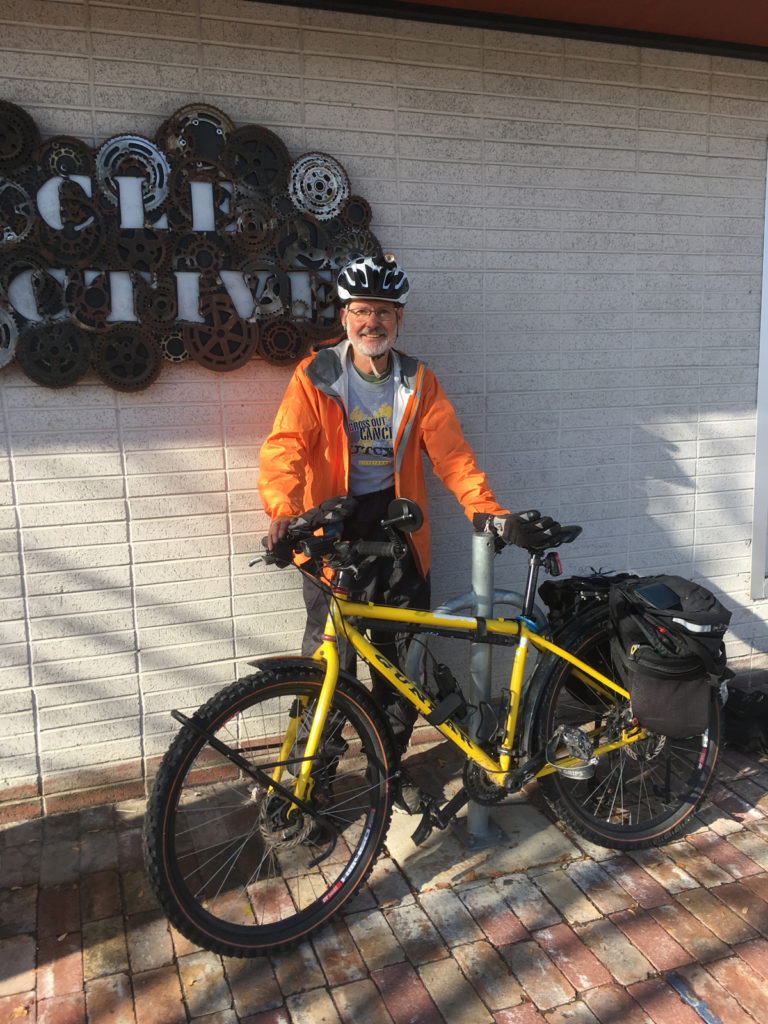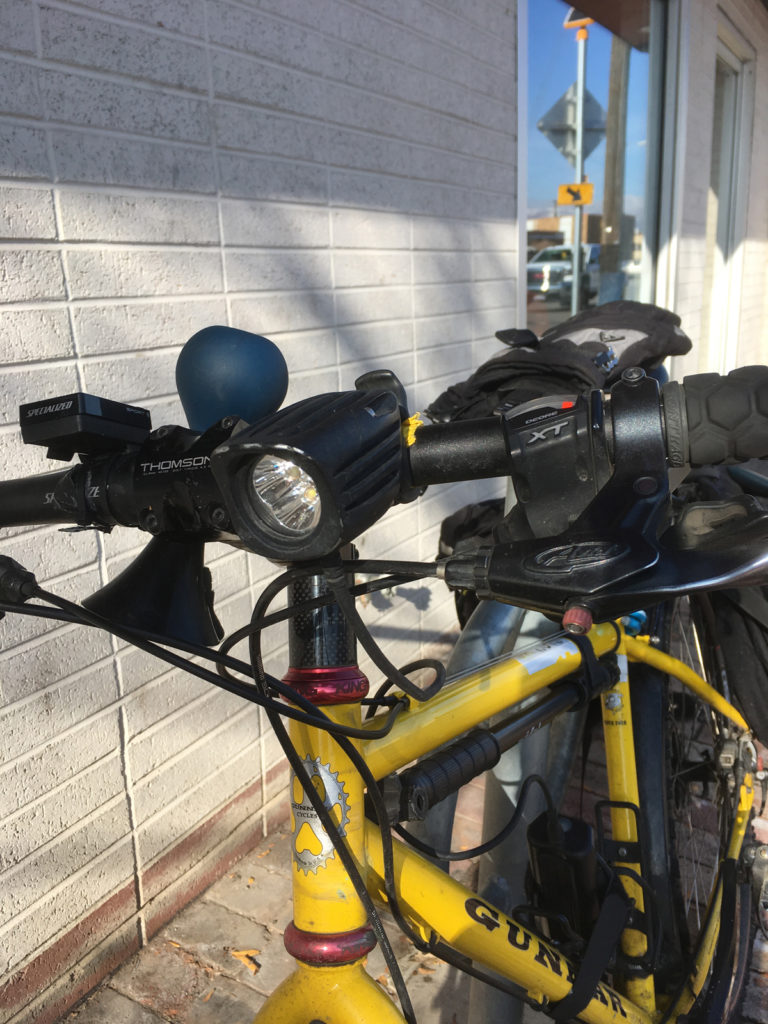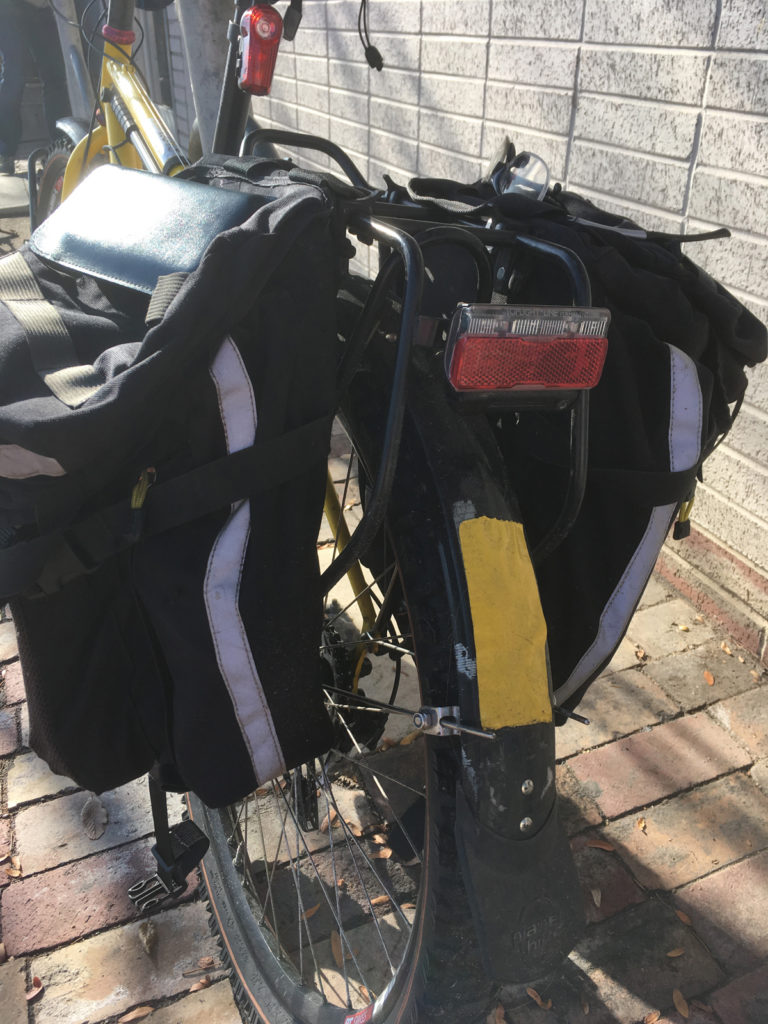By Lou Melini — Commuting to work from early November to late February has unique challenges. Shortened daylight hours, cold temperatures, precipitation in the form of snow along with packed snow or ice on the roads are the primary reasons that most bicycle commuters find alternative transportation during this time period. As I discussed in a commuter column a couple of years ago, having the proper attitude will help make winter commutes successful. Every destination of a commute by bike has unique circumstances so that each of us may have to be creative and individualize how we get through the winter. Tires, clothing for warmth and lights are the 3 main changes one will make to transition from summer commuting.

Tires: I use the same bike for my year-round commuting. It has fenders, lights, and a mirror as standard accessories. What I do different to the bike is change to larger width tires. I move from summer to spring/fall tires and then starting with the first snowfall I put on my winter tires, the widest that will fit my frame. The tires that I have used for the past 2 seasons are 2.35 inches wide and I plan to squeeze in 2.4-inch tires soon. The tires have sidewalls that are stiff so that I can ride at 20 psi without pinch flatting. There is considerable tread for biting into snow, a frequent need for the trail I ride to my volunteer job.
Before I retired, the tires I used were 2.1 inches and the need for deep treads was less unless a snowstorm hit prior to leaving my house. I had a “fat-tire” Surly Pugsley for a couple of seasons that would take me to work and home in any wintry road condition. including patches of ice. The tire pressure was 9-10 psi on that bike.
I am habituated to what I have been using for winter riding. There are other options for tires that I have not used aside from the wide tires with tubes. Commuters that use studded tires have expressed satisfaction with them. If I had snow packed roads to navigate on a daily basis I would probably switch to them. Another option that I also have not used is large volume tubeless tires for commuting. One can have low pressure for better traction and less worry about a pinch flat.
Accessories: Fenders, lights and mirrors are standard equipment for me. Due to my age and age related stiffness, I consider having a mirror a necessity. I still need to turn to look behind but the mirror helps give me an idea of traffic. During a snowstorm I am really focused on the road in front of me to pick the best line, with occasional glances in the mirror to see what is coming up behind me. Having a “Plan B” for those days may be a smarter choice but I have managed without incident.
Fenders are great when the temperature is “warm” enough for the snow to be slush. Cold, muddy slush is miserable even with a waterproof rain jacket and pants. If you do not have fenders, you will find out if your rain gear needs replacing or you wished you went with the better quality gear.
Clothing: After I retired, I replaced my Speedplay Frog pedals, cleated mountain bike shoes and over-booties for hiking shoes and flat pedals with Power-Grips brand straps. The change was more practical for my current situation. When the weather is very cold and/or wet I use a waterproof sock over a liner sock. I have a short gaiter that I put on my low-top hiking shoe. I carry a backup pair of socks and plastic bags in my panniers as “emergency” supplies. This combination works well in all sorts of weather.
There is a saying that “As one gets old, you will be cold”. I find that I am wearing an extra layer for my commutes compared to 8 years ago when I turned 60. I wear a wind or rain jacket nearly everyday when the temperature drops below 40. Rain pants for the downhill portion of my commute is standard clothing, especially in the mornings and of course in slushy or snowy conditions. The number of layers that I wear is sometimes laughable. I only purchase jackets with hoods as the hood provides extra warmth. I have a “one-size-fits-all” helmet so I can fit a warm hat and the hood under the helmet and sometime a “Buff” brand neck-gaiter. Pit zips and bright colors are features that I look for in a rain jacket that vary in cost. At best, you will have 5 years of solid performance from a jacket before you experience some leakage due to the water proof coating breaking down with longer use from a pricier jacket with multi-layers with Gore-Tex. I have used Marmot PreCip (non-cycling specific) jackets that worked well for several years acquiring one for as little as $50.
I rarely have cold feet during my commutes but I have had a terrible time with my hands staying warm. My warmest combination (good to 5 below zero) has been a pair of Giro lobster-mitt style gloves rated to 15 degrees and Bar Mitts on my handlebars. The Giro gloves have been surprisingly true to the temperature rating for their slim profile. The Bar Mitts have been great to extend my commute by 20 degrees, though they are snug and hinder the operation of my shifting a bit on my flat bars. I have shoeboxes with gloves. Each box is marked for different temperature ratings. Gloves move from one box to another as the gloves become less warm with use and time. I have also found that due to wind, humidity, location, riding up or downhill and perhaps other factors, one 20 degree day is colder than another 20 degree day For example, when I commuted to my job before retiring, I had to select gloves for Big Cottonwood Park (13th East and 45th South) as the temperature through and near this park was 10 or more degrees colder than my home (3300 East and 2900 South).

Lights: It has been 6 years since I last wrote about lights so without a lot of redundancy I will summarize what I said then which is still relevant today. Lights on a bike are like lights on a car, why go without them! Lights have come down in price over the years. One cannot have too many lights! I still have my 400-lumen Tri-Newt that I purchased 15 years ago if I remember correctly. I’ve sent it back to NiteRider once for a damaged cable. I also have a 120-lumen Light and Motion light on my helmet that I keep in the flashing mode.
On the rear of my bike I have a Planet Bike Superflash light attached to my seatpost, a non-flashing Busch and Müller light attached to my rack and a flashing light on the back of my helmet that is part of the Light and Motion Vis-360 system. In total I paid about $600 for all of these lights many years ago. Today I could get a similar output of lumens for less than $250; and the newer model Planet Bike Superflash is charged through a USB port vs. batteries. (Note that part of the reason for 3 lights is that when I go shopping and overbuy, I have a grocery bag strapped to my rack obscuring the seat post light and occasionally the rack light.)

I put a Bontrager Flare RT light ($60) on the back Julie’s bike during our ride across the U.S. in 2018. This light is super bright. I could see this light for 0.5 miles during the pre-dawn start our day across the Kansas.
Currently from Planet Bike, a Blaze 800 and a Superflash costs $100. Light and Motion has a front (900 lumens) and rear combo listed at $100 as well. NiteRider also has jumped into the $100 light package with a 1000 lumen front light. Price should not be a reason for not having a light!
I have grown to like my helmet light, not only as a back up for my handlebar mounted light, but also for the flash mode that allows me to turn my head and direct a light at a car coming from the left or right. I do not have experience with hub-generated lights such as the Schmidt hub dynamo (SON hub) but those that have them have been happy.
Safety: The short answer to the question of safety is that winter riding is safe with reasonable care. If the potential of riding on snow or ice is of concern go to an empty parking lot after a snowstorm. Ride in a straight line, figure 8’s, speed up and quickly slow down, and don’t forget to practice braking. Know your commute route well. Ice may be present on the north facing side of a street where there is a tree and shadows slowing the melting of ice. Riding on untracked snow will avoid slippery conditions. On the other hand, sometimes riding on the road is necessary, as cars may have cleared a path down to the road surface to ride on. Bus routes and roads near schools will be plowed first however these routes will have much more traffic. There is no shame in a plan B be it a car, bus or Trax, or a taxi.
Riding in cold and/or wet conditions can change the characteristics of your bike. I have read that cold temperatures will reduce tire traction. Also that latex found in most tubeless sealants doesn’t cure as well even in temperatures in the low 40’s though I haven’t noticed this to be significant in my commuting and cyclocross racing. Sharp objects that could cause a puncture stay attached to tires longer when the tire surface is wet thus increasing your chance of a puncture. Anything that is not asphalt such as road paint, metal manhole covers, railroad tracks, etc. are much more slippery when wet so avoid leaning into them. And finally a light rain will create a slippery surface as it mixes with debris on the road surface (oil, dust, and such). A heavy rain usually washes this stuff away.
Remember, your commute time will be a bit longer, as will the time it takes to get dressed at home and undressed at work. The more you ride in winter, the more skilled and comfortable you will be but don’t get overconfident. I will admit, there have been a few days over the past several decades when I’ve asked myself, “what the hell am I doing out here”. I have not had a serious incident but I have fallen on ice twice. Have a happy commute!


No facemask, Lou? Much wind-chill rides with you!